Cherelle Lasseter, HIS1101: George Washington & French Indian War
VerifiedAdded on 2022/11/11
|9
|2714
|338
Essay
AI Summary
This essay explores the role of George Washington in the French and Indian War, also known as the Seven Years' War, fought between 1754 and 1763. It discusses how Washington's actions, particularly his mission to the Ohio Valley and subsequent skirmishes with the French, are considered to have sparked the conflict. The essay details Washington's early military career, his leadership during the war, including the Battle of Fort Necessity, and his strategies and alliances. It highlights the historical context of the war, including the preceding territorial conflicts and the scramble for colonies by European powers, and the importance of the war for the fur trade. Finally, it emphasizes Washington's significance in American history, tracing his rise from a young military figure to the first president of the United States and his influence on the American Revolution and the formation of the US constitution.
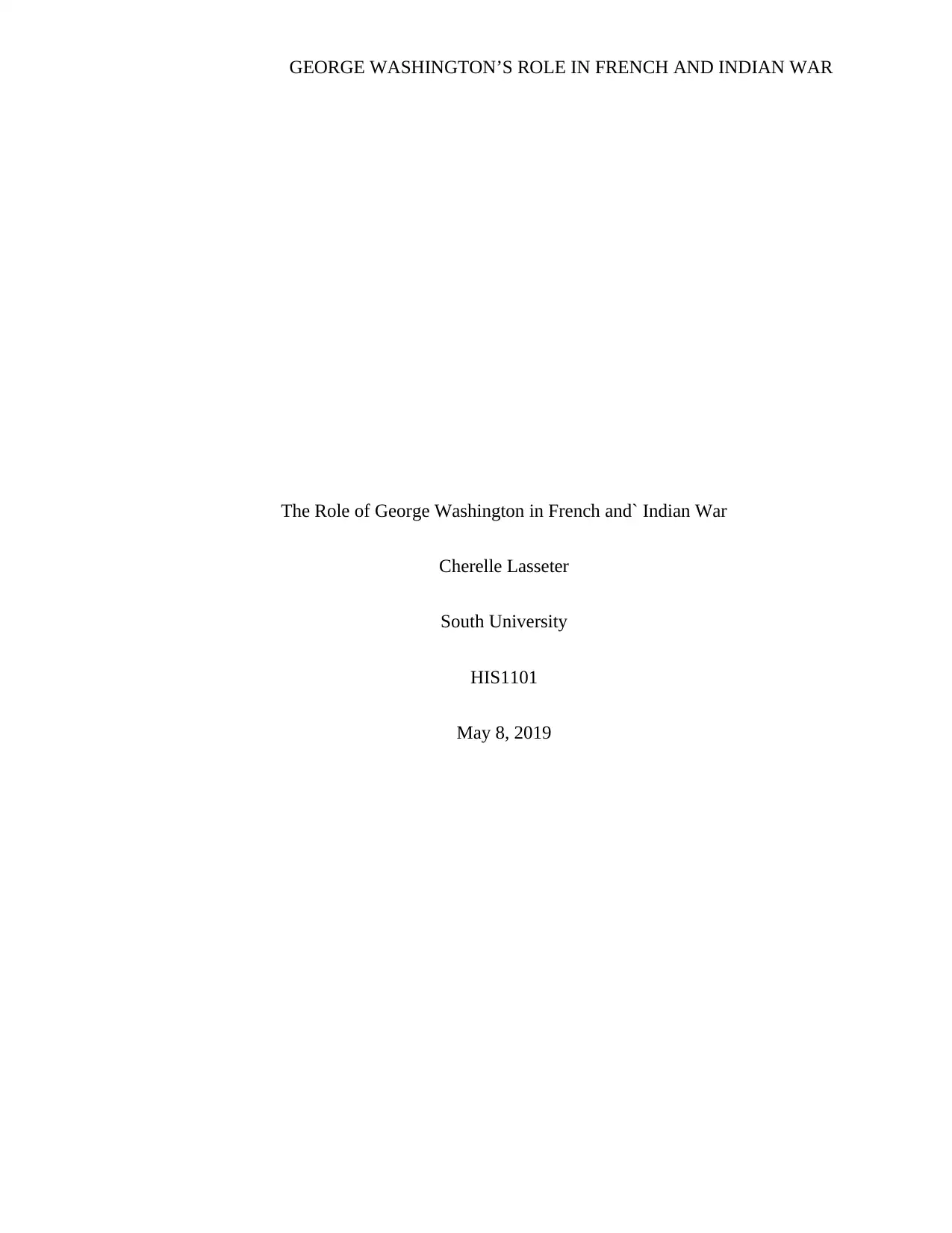
GEORGE WASHINGTON’S ROLE IN FRENCH AND INDIAN WAR
The Role of George Washington in French and` Indian War
Cherelle Lasseter
South University
HIS1101
May 8, 2019
The Role of George Washington in French and` Indian War
Cherelle Lasseter
South University
HIS1101
May 8, 2019
Paraphrase This Document
Need a fresh take? Get an instant paraphrase of this document with our AI Paraphraser
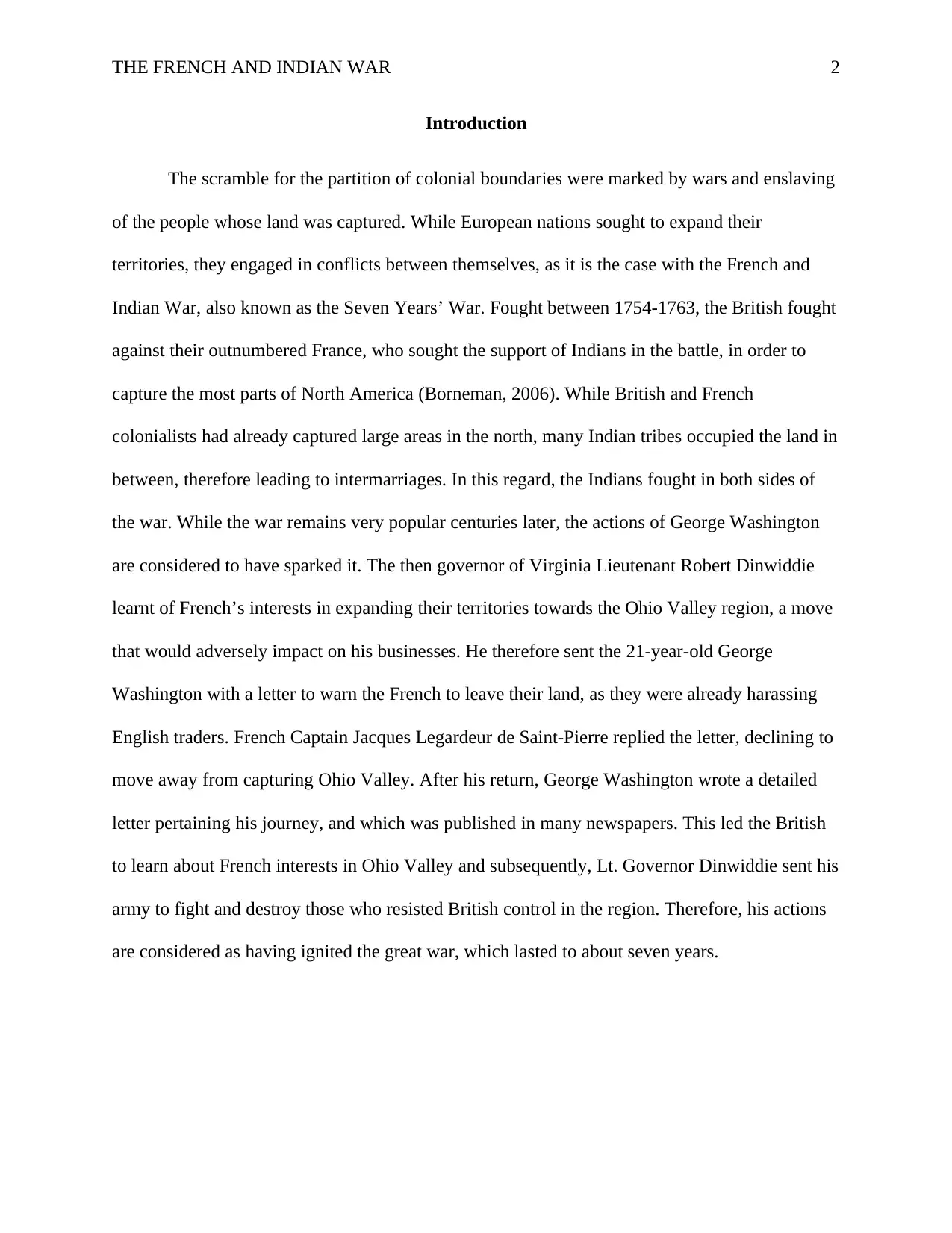
THE FRENCH AND INDIAN WAR 2
Introduction
The scramble for the partition of colonial boundaries were marked by wars and enslaving
of the people whose land was captured. While European nations sought to expand their
territories, they engaged in conflicts between themselves, as it is the case with the French and
Indian War, also known as the Seven Years’ War. Fought between 1754-1763, the British fought
against their outnumbered France, who sought the support of Indians in the battle, in order to
capture the most parts of North America (Borneman, 2006). While British and French
colonialists had already captured large areas in the north, many Indian tribes occupied the land in
between, therefore leading to intermarriages. In this regard, the Indians fought in both sides of
the war. While the war remains very popular centuries later, the actions of George Washington
are considered to have sparked it. The then governor of Virginia Lieutenant Robert Dinwiddie
learnt of French’s interests in expanding their territories towards the Ohio Valley region, a move
that would adversely impact on his businesses. He therefore sent the 21-year-old George
Washington with a letter to warn the French to leave their land, as they were already harassing
English traders. French Captain Jacques Legardeur de Saint-Pierre replied the letter, declining to
move away from capturing Ohio Valley. After his return, George Washington wrote a detailed
letter pertaining his journey, and which was published in many newspapers. This led the British
to learn about French interests in Ohio Valley and subsequently, Lt. Governor Dinwiddie sent his
army to fight and destroy those who resisted British control in the region. Therefore, his actions
are considered as having ignited the great war, which lasted to about seven years.
Introduction
The scramble for the partition of colonial boundaries were marked by wars and enslaving
of the people whose land was captured. While European nations sought to expand their
territories, they engaged in conflicts between themselves, as it is the case with the French and
Indian War, also known as the Seven Years’ War. Fought between 1754-1763, the British fought
against their outnumbered France, who sought the support of Indians in the battle, in order to
capture the most parts of North America (Borneman, 2006). While British and French
colonialists had already captured large areas in the north, many Indian tribes occupied the land in
between, therefore leading to intermarriages. In this regard, the Indians fought in both sides of
the war. While the war remains very popular centuries later, the actions of George Washington
are considered to have sparked it. The then governor of Virginia Lieutenant Robert Dinwiddie
learnt of French’s interests in expanding their territories towards the Ohio Valley region, a move
that would adversely impact on his businesses. He therefore sent the 21-year-old George
Washington with a letter to warn the French to leave their land, as they were already harassing
English traders. French Captain Jacques Legardeur de Saint-Pierre replied the letter, declining to
move away from capturing Ohio Valley. After his return, George Washington wrote a detailed
letter pertaining his journey, and which was published in many newspapers. This led the British
to learn about French interests in Ohio Valley and subsequently, Lt. Governor Dinwiddie sent his
army to fight and destroy those who resisted British control in the region. Therefore, his actions
are considered as having ignited the great war, which lasted to about seven years.
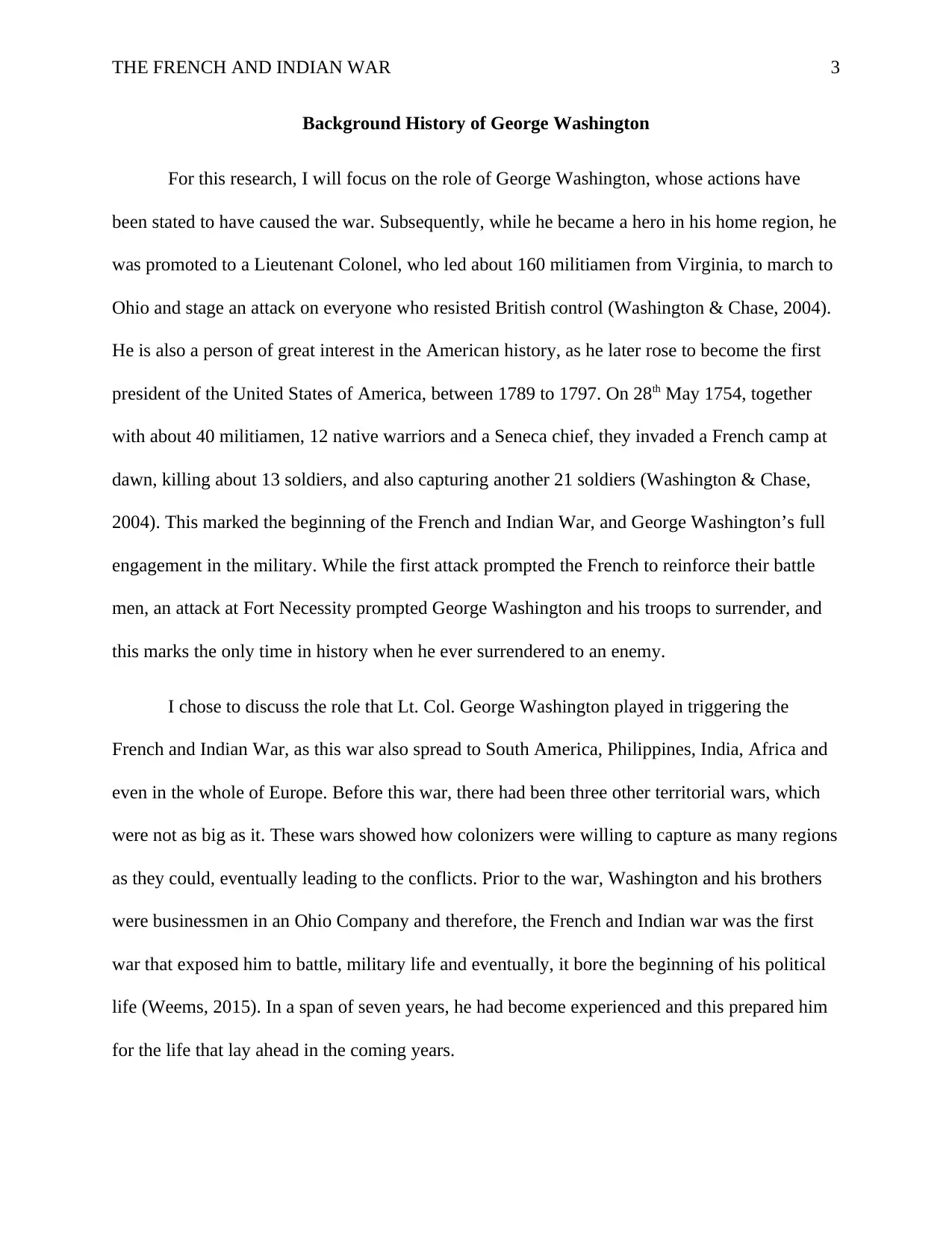
THE FRENCH AND INDIAN WAR 3
Background History of George Washington
For this research, I will focus on the role of George Washington, whose actions have
been stated to have caused the war. Subsequently, while he became a hero in his home region, he
was promoted to a Lieutenant Colonel, who led about 160 militiamen from Virginia, to march to
Ohio and stage an attack on everyone who resisted British control (Washington & Chase, 2004).
He is also a person of great interest in the American history, as he later rose to become the first
president of the United States of America, between 1789 to 1797. On 28th May 1754, together
with about 40 militiamen, 12 native warriors and a Seneca chief, they invaded a French camp at
dawn, killing about 13 soldiers, and also capturing another 21 soldiers (Washington & Chase,
2004). This marked the beginning of the French and Indian War, and George Washington’s full
engagement in the military. While the first attack prompted the French to reinforce their battle
men, an attack at Fort Necessity prompted George Washington and his troops to surrender, and
this marks the only time in history when he ever surrendered to an enemy.
I chose to discuss the role that Lt. Col. George Washington played in triggering the
French and Indian War, as this war also spread to South America, Philippines, India, Africa and
even in the whole of Europe. Before this war, there had been three other territorial wars, which
were not as big as it. These wars showed how colonizers were willing to capture as many regions
as they could, eventually leading to the conflicts. Prior to the war, Washington and his brothers
were businessmen in an Ohio Company and therefore, the French and Indian war was the first
war that exposed him to battle, military life and eventually, it bore the beginning of his political
life (Weems, 2015). In a span of seven years, he had become experienced and this prepared him
for the life that lay ahead in the coming years.
Background History of George Washington
For this research, I will focus on the role of George Washington, whose actions have
been stated to have caused the war. Subsequently, while he became a hero in his home region, he
was promoted to a Lieutenant Colonel, who led about 160 militiamen from Virginia, to march to
Ohio and stage an attack on everyone who resisted British control (Washington & Chase, 2004).
He is also a person of great interest in the American history, as he later rose to become the first
president of the United States of America, between 1789 to 1797. On 28th May 1754, together
with about 40 militiamen, 12 native warriors and a Seneca chief, they invaded a French camp at
dawn, killing about 13 soldiers, and also capturing another 21 soldiers (Washington & Chase,
2004). This marked the beginning of the French and Indian War, and George Washington’s full
engagement in the military. While the first attack prompted the French to reinforce their battle
men, an attack at Fort Necessity prompted George Washington and his troops to surrender, and
this marks the only time in history when he ever surrendered to an enemy.
I chose to discuss the role that Lt. Col. George Washington played in triggering the
French and Indian War, as this war also spread to South America, Philippines, India, Africa and
even in the whole of Europe. Before this war, there had been three other territorial wars, which
were not as big as it. These wars showed how colonizers were willing to capture as many regions
as they could, eventually leading to the conflicts. Prior to the war, Washington and his brothers
were businessmen in an Ohio Company and therefore, the French and Indian war was the first
war that exposed him to battle, military life and eventually, it bore the beginning of his political
life (Weems, 2015). In a span of seven years, he had become experienced and this prepared him
for the life that lay ahead in the coming years.
⊘ This is a preview!⊘
Do you want full access?
Subscribe today to unlock all pages.

Trusted by 1+ million students worldwide
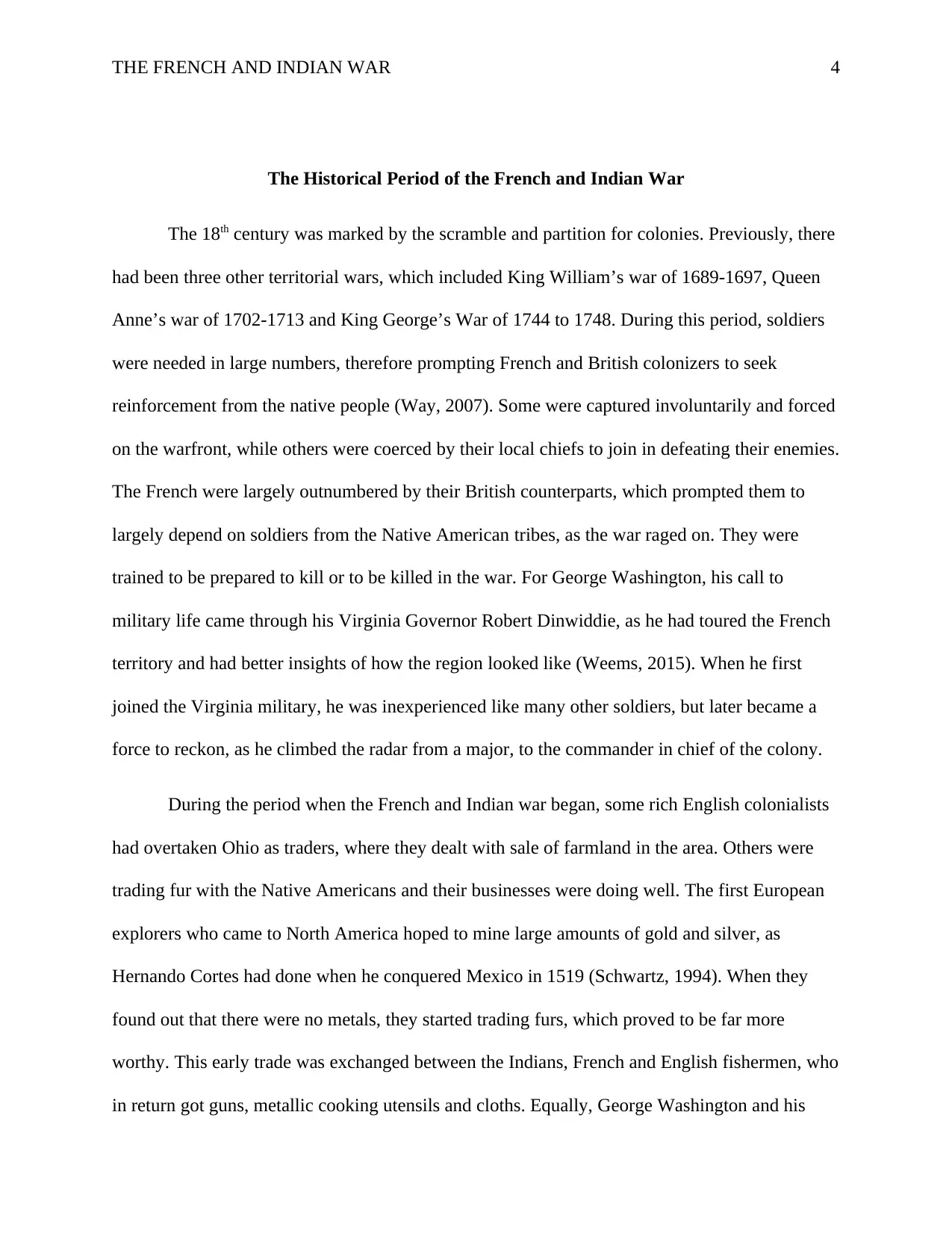
THE FRENCH AND INDIAN WAR 4
The Historical Period of the French and Indian War
The 18th century was marked by the scramble and partition for colonies. Previously, there
had been three other territorial wars, which included King William’s war of 1689-1697, Queen
Anne’s war of 1702-1713 and King George’s War of 1744 to 1748. During this period, soldiers
were needed in large numbers, therefore prompting French and British colonizers to seek
reinforcement from the native people (Way, 2007). Some were captured involuntarily and forced
on the warfront, while others were coerced by their local chiefs to join in defeating their enemies.
The French were largely outnumbered by their British counterparts, which prompted them to
largely depend on soldiers from the Native American tribes, as the war raged on. They were
trained to be prepared to kill or to be killed in the war. For George Washington, his call to
military life came through his Virginia Governor Robert Dinwiddie, as he had toured the French
territory and had better insights of how the region looked like (Weems, 2015). When he first
joined the Virginia military, he was inexperienced like many other soldiers, but later became a
force to reckon, as he climbed the radar from a major, to the commander in chief of the colony.
During the period when the French and Indian war began, some rich English colonialists
had overtaken Ohio as traders, where they dealt with sale of farmland in the area. Others were
trading fur with the Native Americans and their businesses were doing well. The first European
explorers who came to North America hoped to mine large amounts of gold and silver, as
Hernando Cortes had done when he conquered Mexico in 1519 (Schwartz, 1994). When they
found out that there were no metals, they started trading furs, which proved to be far more
worthy. This early trade was exchanged between the Indians, French and English fishermen, who
in return got guns, metallic cooking utensils and cloths. Equally, George Washington and his
The Historical Period of the French and Indian War
The 18th century was marked by the scramble and partition for colonies. Previously, there
had been three other territorial wars, which included King William’s war of 1689-1697, Queen
Anne’s war of 1702-1713 and King George’s War of 1744 to 1748. During this period, soldiers
were needed in large numbers, therefore prompting French and British colonizers to seek
reinforcement from the native people (Way, 2007). Some were captured involuntarily and forced
on the warfront, while others were coerced by their local chiefs to join in defeating their enemies.
The French were largely outnumbered by their British counterparts, which prompted them to
largely depend on soldiers from the Native American tribes, as the war raged on. They were
trained to be prepared to kill or to be killed in the war. For George Washington, his call to
military life came through his Virginia Governor Robert Dinwiddie, as he had toured the French
territory and had better insights of how the region looked like (Weems, 2015). When he first
joined the Virginia military, he was inexperienced like many other soldiers, but later became a
force to reckon, as he climbed the radar from a major, to the commander in chief of the colony.
During the period when the French and Indian war began, some rich English colonialists
had overtaken Ohio as traders, where they dealt with sale of farmland in the area. Others were
trading fur with the Native Americans and their businesses were doing well. The first European
explorers who came to North America hoped to mine large amounts of gold and silver, as
Hernando Cortes had done when he conquered Mexico in 1519 (Schwartz, 1994). When they
found out that there were no metals, they started trading furs, which proved to be far more
worthy. This early trade was exchanged between the Indians, French and English fishermen, who
in return got guns, metallic cooking utensils and cloths. Equally, George Washington and his
Paraphrase This Document
Need a fresh take? Get an instant paraphrase of this document with our AI Paraphraser
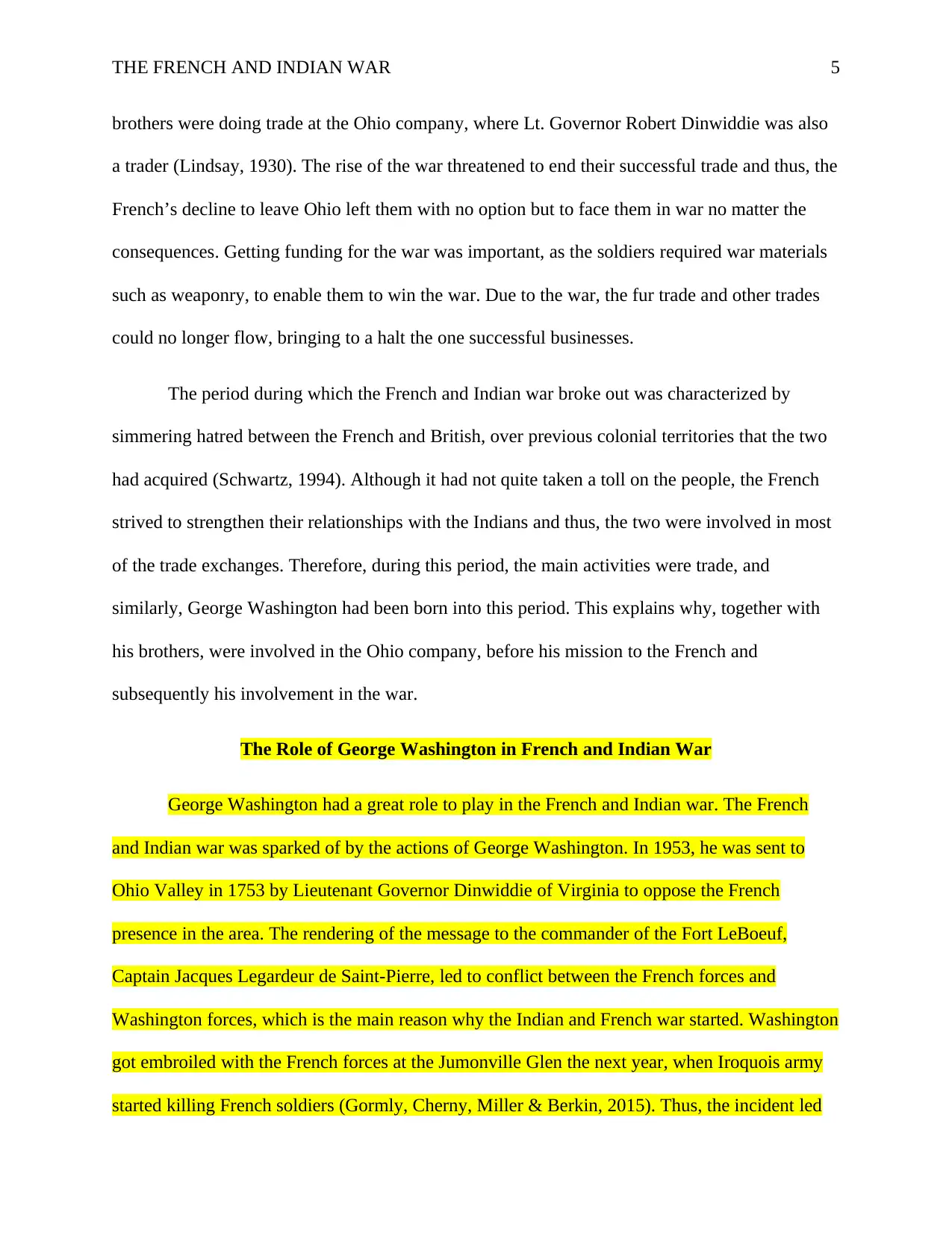
THE FRENCH AND INDIAN WAR 5
brothers were doing trade at the Ohio company, where Lt. Governor Robert Dinwiddie was also
a trader (Lindsay, 1930). The rise of the war threatened to end their successful trade and thus, the
French’s decline to leave Ohio left them with no option but to face them in war no matter the
consequences. Getting funding for the war was important, as the soldiers required war materials
such as weaponry, to enable them to win the war. Due to the war, the fur trade and other trades
could no longer flow, bringing to a halt the one successful businesses.
The period during which the French and Indian war broke out was characterized by
simmering hatred between the French and British, over previous colonial territories that the two
had acquired (Schwartz, 1994). Although it had not quite taken a toll on the people, the French
strived to strengthen their relationships with the Indians and thus, the two were involved in most
of the trade exchanges. Therefore, during this period, the main activities were trade, and
similarly, George Washington had been born into this period. This explains why, together with
his brothers, were involved in the Ohio company, before his mission to the French and
subsequently his involvement in the war.
The Role of George Washington in French and Indian War
George Washington had a great role to play in the French and Indian war. The French
and Indian war was sparked of by the actions of George Washington. In 1953, he was sent to
Ohio Valley in 1753 by Lieutenant Governor Dinwiddie of Virginia to oppose the French
presence in the area. The rendering of the message to the commander of the Fort LeBoeuf,
Captain Jacques Legardeur de Saint-Pierre, led to conflict between the French forces and
Washington forces, which is the main reason why the Indian and French war started. Washington
got embroiled with the French forces at the Jumonville Glen the next year, when Iroquois army
started killing French soldiers (Gormly, Cherny, Miller & Berkin, 2015). Thus, the incident led
brothers were doing trade at the Ohio company, where Lt. Governor Robert Dinwiddie was also
a trader (Lindsay, 1930). The rise of the war threatened to end their successful trade and thus, the
French’s decline to leave Ohio left them with no option but to face them in war no matter the
consequences. Getting funding for the war was important, as the soldiers required war materials
such as weaponry, to enable them to win the war. Due to the war, the fur trade and other trades
could no longer flow, bringing to a halt the one successful businesses.
The period during which the French and Indian war broke out was characterized by
simmering hatred between the French and British, over previous colonial territories that the two
had acquired (Schwartz, 1994). Although it had not quite taken a toll on the people, the French
strived to strengthen their relationships with the Indians and thus, the two were involved in most
of the trade exchanges. Therefore, during this period, the main activities were trade, and
similarly, George Washington had been born into this period. This explains why, together with
his brothers, were involved in the Ohio company, before his mission to the French and
subsequently his involvement in the war.
The Role of George Washington in French and Indian War
George Washington had a great role to play in the French and Indian war. The French
and Indian war was sparked of by the actions of George Washington. In 1953, he was sent to
Ohio Valley in 1753 by Lieutenant Governor Dinwiddie of Virginia to oppose the French
presence in the area. The rendering of the message to the commander of the Fort LeBoeuf,
Captain Jacques Legardeur de Saint-Pierre, led to conflict between the French forces and
Washington forces, which is the main reason why the Indian and French war started. Washington
got embroiled with the French forces at the Jumonville Glen the next year, when Iroquois army
started killing French soldiers (Gormly, Cherny, Miller & Berkin, 2015). Thus, the incident led
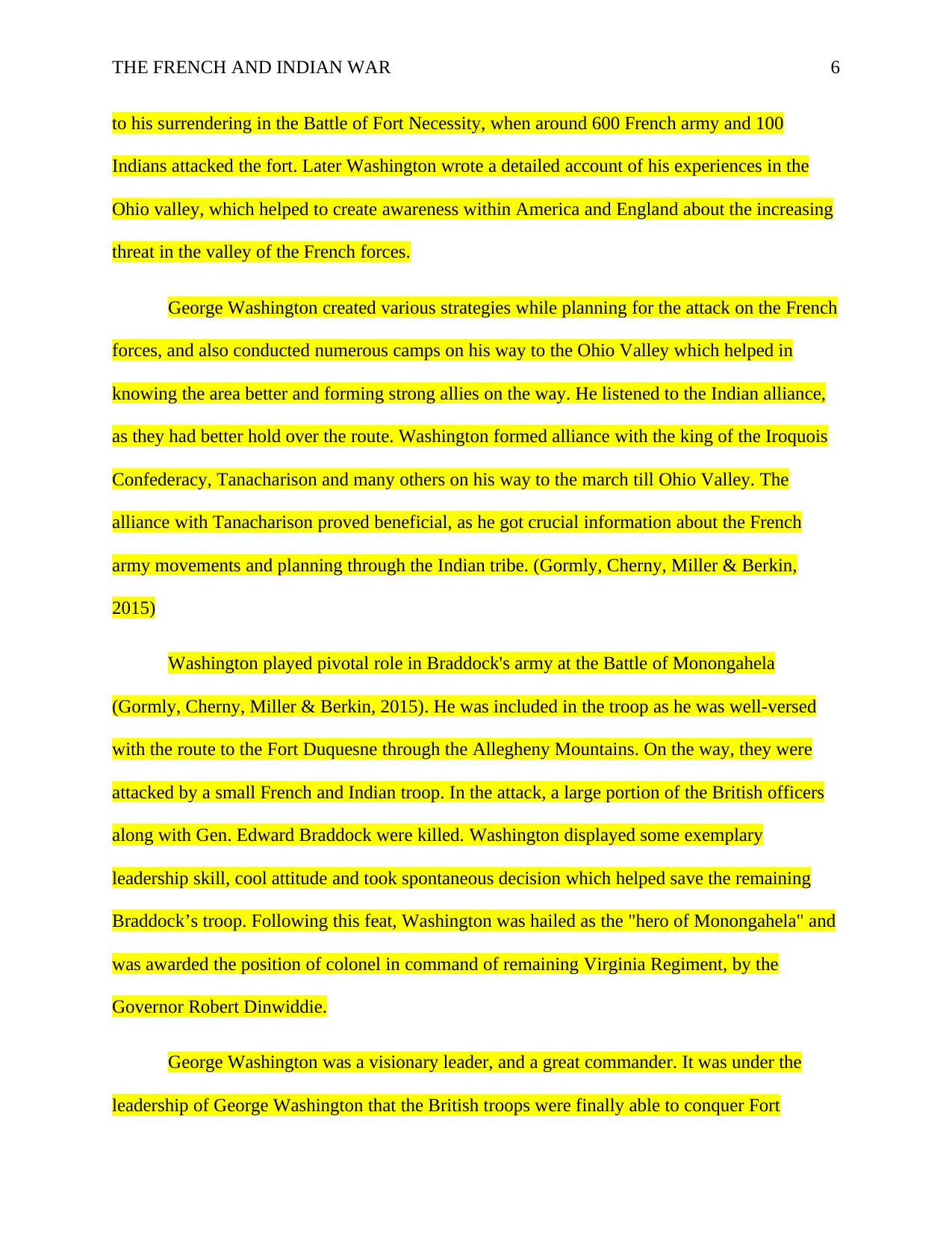
THE FRENCH AND INDIAN WAR 6
to his surrendering in the Battle of Fort Necessity, when around 600 French army and 100
Indians attacked the fort. Later Washington wrote a detailed account of his experiences in the
Ohio valley, which helped to create awareness within America and England about the increasing
threat in the valley of the French forces.
George Washington created various strategies while planning for the attack on the French
forces, and also conducted numerous camps on his way to the Ohio Valley which helped in
knowing the area better and forming strong allies on the way. He listened to the Indian alliance,
as they had better hold over the route. Washington formed alliance with the king of the Iroquois
Confederacy, Tanacharison and many others on his way to the march till Ohio Valley. The
alliance with Tanacharison proved beneficial, as he got crucial information about the French
army movements and planning through the Indian tribe. (Gormly, Cherny, Miller & Berkin,
2015)
Washington played pivotal role in Braddock's army at the Battle of Monongahela
(Gormly, Cherny, Miller & Berkin, 2015). He was included in the troop as he was well-versed
with the route to the Fort Duquesne through the Allegheny Mountains. On the way, they were
attacked by a small French and Indian troop. In the attack, a large portion of the British officers
along with Gen. Edward Braddock were killed. Washington displayed some exemplary
leadership skill, cool attitude and took spontaneous decision which helped save the remaining
Braddock’s troop. Following this feat, Washington was hailed as the "hero of Monongahela" and
was awarded the position of colonel in command of remaining Virginia Regiment, by the
Governor Robert Dinwiddie.
George Washington was a visionary leader, and a great commander. It was under the
leadership of George Washington that the British troops were finally able to conquer Fort
to his surrendering in the Battle of Fort Necessity, when around 600 French army and 100
Indians attacked the fort. Later Washington wrote a detailed account of his experiences in the
Ohio valley, which helped to create awareness within America and England about the increasing
threat in the valley of the French forces.
George Washington created various strategies while planning for the attack on the French
forces, and also conducted numerous camps on his way to the Ohio Valley which helped in
knowing the area better and forming strong allies on the way. He listened to the Indian alliance,
as they had better hold over the route. Washington formed alliance with the king of the Iroquois
Confederacy, Tanacharison and many others on his way to the march till Ohio Valley. The
alliance with Tanacharison proved beneficial, as he got crucial information about the French
army movements and planning through the Indian tribe. (Gormly, Cherny, Miller & Berkin,
2015)
Washington played pivotal role in Braddock's army at the Battle of Monongahela
(Gormly, Cherny, Miller & Berkin, 2015). He was included in the troop as he was well-versed
with the route to the Fort Duquesne through the Allegheny Mountains. On the way, they were
attacked by a small French and Indian troop. In the attack, a large portion of the British officers
along with Gen. Edward Braddock were killed. Washington displayed some exemplary
leadership skill, cool attitude and took spontaneous decision which helped save the remaining
Braddock’s troop. Following this feat, Washington was hailed as the "hero of Monongahela" and
was awarded the position of colonel in command of remaining Virginia Regiment, by the
Governor Robert Dinwiddie.
George Washington was a visionary leader, and a great commander. It was under the
leadership of George Washington that the British troops were finally able to conquer Fort
⊘ This is a preview!⊘
Do you want full access?
Subscribe today to unlock all pages.

Trusted by 1+ million students worldwide

THE FRENCH AND INDIAN WAR 7
Duquesne on November 24, 1758. The presence of mind and stability that he displayed helped in
keeping the troops motivated under his command. He made spontaneous decisions, but took
them with a thoughtful mind. The strategies formulated by him gave an edge to the army and
they were able to achieve victory in the Indian and French war. Unlike other leaders, he gave
autonomy and liberty to his troops, and also listened to their suggestions.
The Importance of George Washington to the study of American History
George Washington remains a central figure in the study of American history, given his
great involvement in the colonial wars. Having risen from a young inexperienced major to the
indispensable role he played in the formation of one of the strongest countries in the world, he
warrants quite some interest (Weems, 2015). His role in the French and Indian war is
indispensable, as the war shaped the world’s history in the following the colonial wars that
followed in the many parts of the world. His exemplary leadership in the war has characterized
him as one of the best commander in chiefs, escaping the wrath of the war in so many instances
and only surrendering once.
The French and Indian war brought him to light, making him a hero among his people,
and subsequently, shaping his later political life. His military prowess largely helped in his
leadership of America, and in the following American revolution, he was considered as a
national hero. In 1787, he was elected to the team that wrote down the US constitution, before
becoming its president two years later. His position lay the foundation of the modern day
America, as the incoming presidents follow in his steps. In the late 1760s, George Washington
experienced British colonialists imposing heavy taxes on the Americans, which prompted him to
drop his support towards the British and instead, support Americans in revolting against the
harsh taxation (Washington & Chase, 2004). He thus became the commander in chief of the
Duquesne on November 24, 1758. The presence of mind and stability that he displayed helped in
keeping the troops motivated under his command. He made spontaneous decisions, but took
them with a thoughtful mind. The strategies formulated by him gave an edge to the army and
they were able to achieve victory in the Indian and French war. Unlike other leaders, he gave
autonomy and liberty to his troops, and also listened to their suggestions.
The Importance of George Washington to the study of American History
George Washington remains a central figure in the study of American history, given his
great involvement in the colonial wars. Having risen from a young inexperienced major to the
indispensable role he played in the formation of one of the strongest countries in the world, he
warrants quite some interest (Weems, 2015). His role in the French and Indian war is
indispensable, as the war shaped the world’s history in the following the colonial wars that
followed in the many parts of the world. His exemplary leadership in the war has characterized
him as one of the best commander in chiefs, escaping the wrath of the war in so many instances
and only surrendering once.
The French and Indian war brought him to light, making him a hero among his people,
and subsequently, shaping his later political life. His military prowess largely helped in his
leadership of America, and in the following American revolution, he was considered as a
national hero. In 1787, he was elected to the team that wrote down the US constitution, before
becoming its president two years later. His position lay the foundation of the modern day
America, as the incoming presidents follow in his steps. In the late 1760s, George Washington
experienced British colonialists imposing heavy taxes on the Americans, which prompted him to
drop his support towards the British and instead, support Americans in revolting against the
harsh taxation (Washington & Chase, 2004). He thus became the commander in chief of the
Paraphrase This Document
Need a fresh take? Get an instant paraphrase of this document with our AI Paraphraser
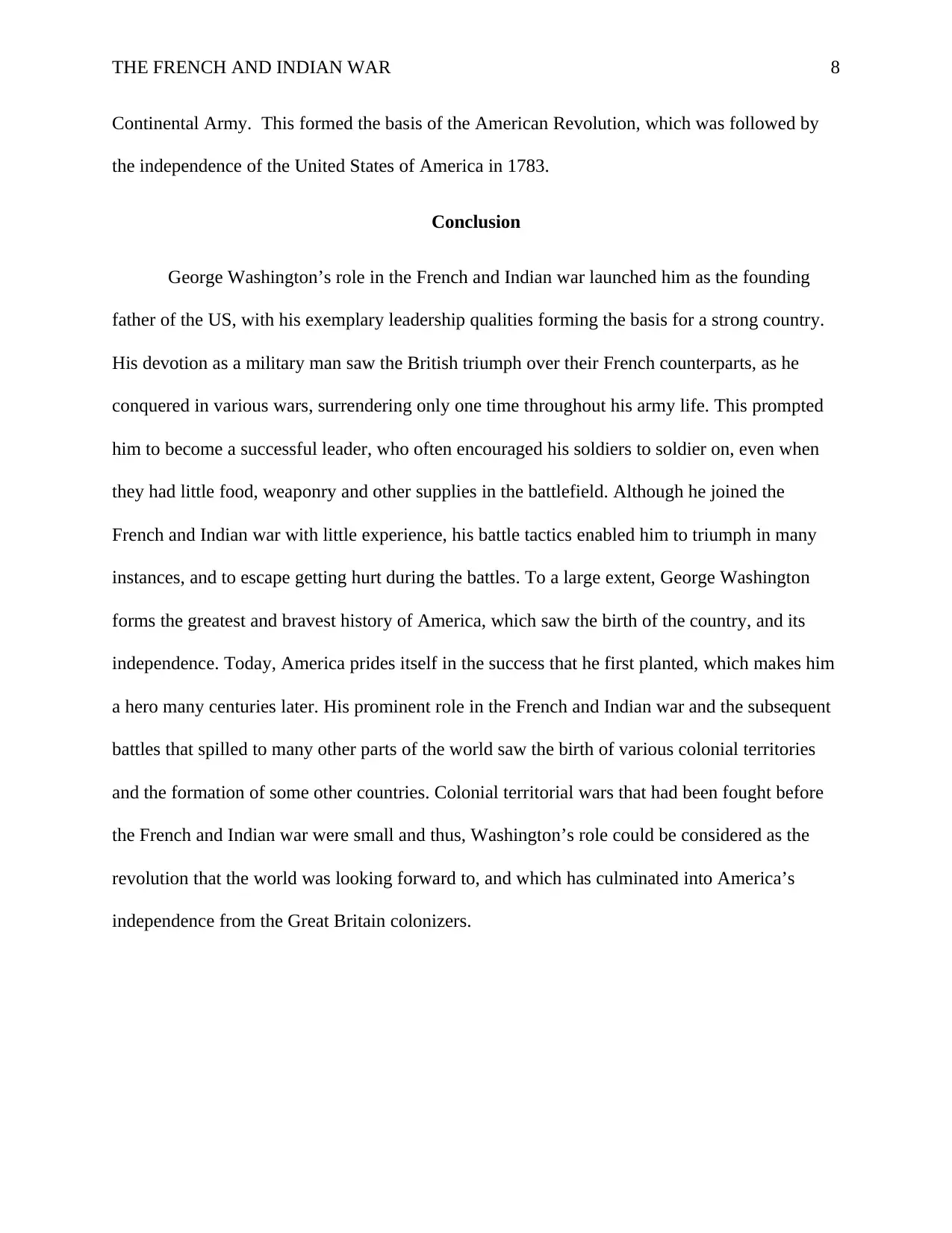
THE FRENCH AND INDIAN WAR 8
Continental Army. This formed the basis of the American Revolution, which was followed by
the independence of the United States of America in 1783.
Conclusion
George Washington’s role in the French and Indian war launched him as the founding
father of the US, with his exemplary leadership qualities forming the basis for a strong country.
His devotion as a military man saw the British triumph over their French counterparts, as he
conquered in various wars, surrendering only one time throughout his army life. This prompted
him to become a successful leader, who often encouraged his soldiers to soldier on, even when
they had little food, weaponry and other supplies in the battlefield. Although he joined the
French and Indian war with little experience, his battle tactics enabled him to triumph in many
instances, and to escape getting hurt during the battles. To a large extent, George Washington
forms the greatest and bravest history of America, which saw the birth of the country, and its
independence. Today, America prides itself in the success that he first planted, which makes him
a hero many centuries later. His prominent role in the French and Indian war and the subsequent
battles that spilled to many other parts of the world saw the birth of various colonial territories
and the formation of some other countries. Colonial territorial wars that had been fought before
the French and Indian war were small and thus, Washington’s role could be considered as the
revolution that the world was looking forward to, and which has culminated into America’s
independence from the Great Britain colonizers.
Continental Army. This formed the basis of the American Revolution, which was followed by
the independence of the United States of America in 1783.
Conclusion
George Washington’s role in the French and Indian war launched him as the founding
father of the US, with his exemplary leadership qualities forming the basis for a strong country.
His devotion as a military man saw the British triumph over their French counterparts, as he
conquered in various wars, surrendering only one time throughout his army life. This prompted
him to become a successful leader, who often encouraged his soldiers to soldier on, even when
they had little food, weaponry and other supplies in the battlefield. Although he joined the
French and Indian war with little experience, his battle tactics enabled him to triumph in many
instances, and to escape getting hurt during the battles. To a large extent, George Washington
forms the greatest and bravest history of America, which saw the birth of the country, and its
independence. Today, America prides itself in the success that he first planted, which makes him
a hero many centuries later. His prominent role in the French and Indian war and the subsequent
battles that spilled to many other parts of the world saw the birth of various colonial territories
and the formation of some other countries. Colonial territorial wars that had been fought before
the French and Indian war were small and thus, Washington’s role could be considered as the
revolution that the world was looking forward to, and which has culminated into America’s
independence from the Great Britain colonizers.
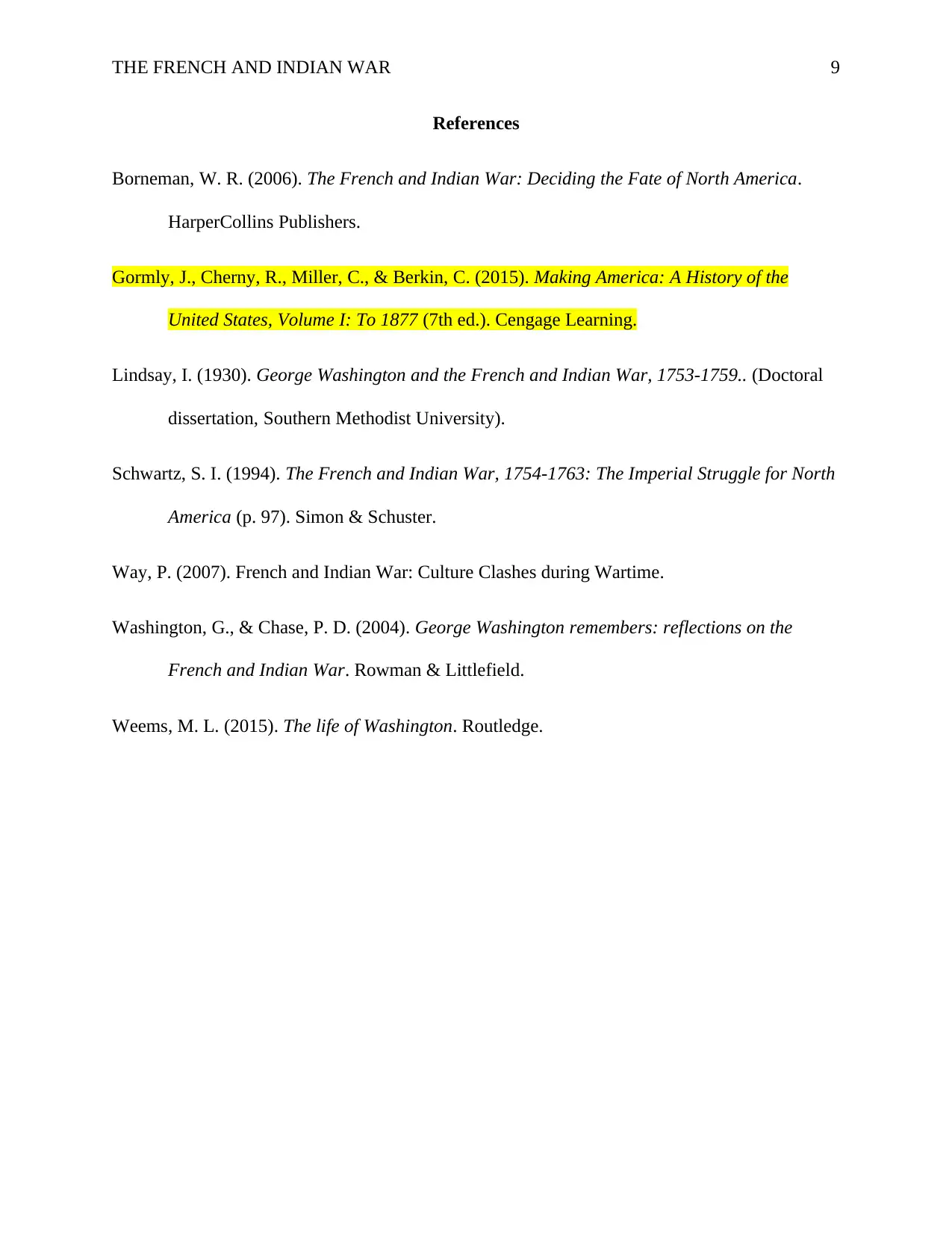
THE FRENCH AND INDIAN WAR 9
References
Borneman, W. R. (2006). The French and Indian War: Deciding the Fate of North America.
HarperCollins Publishers.
Gormly, J., Cherny, R., Miller, C., & Berkin, C. (2015). Making America: A History of the
United States, Volume I: To 1877 (7th ed.). Cengage Learning.
Lindsay, I. (1930). George Washington and the French and Indian War, 1753-1759.. (Doctoral
dissertation, Southern Methodist University).
Schwartz, S. I. (1994). The French and Indian War, 1754-1763: The Imperial Struggle for North
America (p. 97). Simon & Schuster.
Way, P. (2007). French and Indian War: Culture Clashes during Wartime.
Washington, G., & Chase, P. D. (2004). George Washington remembers: reflections on the
French and Indian War. Rowman & Littlefield.
Weems, M. L. (2015). The life of Washington. Routledge.
References
Borneman, W. R. (2006). The French and Indian War: Deciding the Fate of North America.
HarperCollins Publishers.
Gormly, J., Cherny, R., Miller, C., & Berkin, C. (2015). Making America: A History of the
United States, Volume I: To 1877 (7th ed.). Cengage Learning.
Lindsay, I. (1930). George Washington and the French and Indian War, 1753-1759.. (Doctoral
dissertation, Southern Methodist University).
Schwartz, S. I. (1994). The French and Indian War, 1754-1763: The Imperial Struggle for North
America (p. 97). Simon & Schuster.
Way, P. (2007). French and Indian War: Culture Clashes during Wartime.
Washington, G., & Chase, P. D. (2004). George Washington remembers: reflections on the
French and Indian War. Rowman & Littlefield.
Weems, M. L. (2015). The life of Washington. Routledge.
⊘ This is a preview!⊘
Do you want full access?
Subscribe today to unlock all pages.

Trusted by 1+ million students worldwide
1 out of 9
Your All-in-One AI-Powered Toolkit for Academic Success.
+13062052269
info@desklib.com
Available 24*7 on WhatsApp / Email
![[object Object]](/_next/static/media/star-bottom.7253800d.svg)
Unlock your academic potential
Copyright © 2020–2025 A2Z Services. All Rights Reserved. Developed and managed by ZUCOL.

